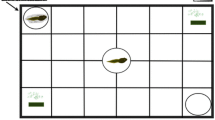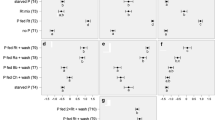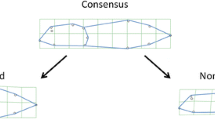Abstract
Prey use chemical cues from predation events to obtain information about predation risk to alter their phenotypes. Though we know how many prey respond to predators, we still have a poor understanding of the processes and chemical cues involved during a predation event. We examined how gray treefrog tadpoles (Hyla versicolor) altered their behavior and morphology when raised with cues from different stages of predator attack, predators fed different amounts of prey, and predators consuming different combinations of treefrog tadpoles or snails (Helisoma trivolvis). We found that starved predators and predators fed snails induced no defensive responses whereas tadpoles exposed to a predator consuming gray treefrogs induced greater hiding, lower activity, and relatively deeper tails. We also found that the tadpoles did not respond to crushed, chewed, or digested conspecifics, but they did respond to consumed (i.e., chewed plus digested) conspecifics. When we increased the treefrog biomass consumed by predators, tadpoles frequently increased their defenses when only tadpoles were consumed and always increased their defenses when the total diet biomass was held constant via the inclusion of snails. When predators experienced temporal variation in diet composition, including cues from snails to cause additional digestive cues or chemical noise, there was no effect on tadpole phenotypes. Our results suggest that amphibian prey rely on cues from both chewing and digestion of conspecifics and that the presence of cues from digested heterospecifics play little or no role in adding chemical noise or increased digestive enzymes and by-products that could potentially interfere with induced defenses.


Similar content being viewed by others
References
Altwegg R, Reyer HU (2003) Patterns of natural selection on size at metamorphosis in water frogs. Evolution 57:872–882
Blanchet S, Clobert J, Danchin É (2010) The role of public information in ecology and conservation: an emphasis on inadvertent social information. Ann NY Acad Sci 1195:149–168
Bolnick DI, Svanbäck R, Araújo MS, Persson L (2007) Comparative support for the niche variation hypothesis that more generalized populations also are more heterogeneous. Proc Natl Acad Sci 104:10075–10079
Bourdeau PE (2009) Prioritized phenotypic responses to combined predators in a marine snail. Ecology 90:1659–1669
Bourdeau PE (2010) Cue reliability, risk sensitivity and inducible morphological defense in a marine snail. Oecologia 162:987–994
Bouskila A, Blumstein DT (1992) Rules of thumb for predation hazard assessment: predictions from a dynamic model. Am Nat 139:161–176
Brown GE (2003) Learning about danger: chemical alarm cues and local risk assessment in prey fishes. Fish Fish 4:227–234
Burks RL, Lodge DM (2002) Cued in: advances and opportunities in freshwater chemical ecology. J Chem Ecol 28:1901–1917
Chivers DP, Smith RJF (1998) Chemical alarm signalling in aquatic predator–prey systems: a review and prospectus. Ecoscience 5:338–352
Chivers DP, Kiesecker JM, Anderson MT, Wildy EL, Blaustein AR (1996) Avoidance response of a terrestrial salamander (Ambystoma macrodactylum) to chemical alarm cues. J Chem Ecol 22:1709–1716
Chivers DP, Zhao X, Brown GE, Marchant TA, Ferrari MC (2008) Predator-induced changes in morphology of a prey fish: the effects of food level and temporal frequency of predation risk. Evol Ecol 22:561–574
Clark CW, Harvell CD (1992) Inducible defenses and the allocation of resources: a minimal model. Am Nat 139:521–539
Creel S, Winnie JA, Christianson D, Liley S (2008) Time and space in general models of antipredator response: tests with wolves and elk. Anim Behav 76:1139–1146
Dalesman S, Rundle SD, Bilton DT, Cotton PA (2007a) Phylogenetic relatedness and ecological interactions determine antipredator behavior. Ecology 88:2462–2467
Dalesman S, Rundle SD, Cotton PA (2007b) Predator regime influences innate anti-predator behaviour in the freshwater gastropod Lymnaea stagnalis. Freshwater Biol 52:2134–2140
DeWitt TJ, Sih A, Wilson DS (1998) Costs and limits of phenotypic plasticity. Trends Ecol Evol 13:77–81
DeWitt TJ, Robinson BW, Wilson DS (2000) Functional diversity among predators of a freshwater snail imposes an adaptive trade-off for shell morphology. Evol Ecol Res 2:129–148
Dicke M, Grostal P (2001) Chemical detection of natural enemies by arthropods: an ecological perspective. Annu Rev Ecol Syst 32:1–23
Donaldson-Matasci MC, Bergstrom CT, Lachmann M (2010) The fitness value of information. Oikos 119:219–230
Eklöv P, Werner EE (2000) Multiple predator effects on size-dependent behavior and mortality of two species of anuran larvae. Oikos 88:250–258
Ferrari MC, Chivers DP (2009) Temporal variability, threat sensitivity and conflicting information about the nature of risk: understanding the dynamics of tadpole antipredator behaviour. Anim Behav 78:11–16
Ferrari MC, Wisenden BD, Chivers DP (2010) Chemical ecology of predator-prey interactions in aquatic ecosystems: a review and prospectus. Can J Zool 88:698–724
Ferrero DM, Lemon JK, Fluegge D, Pashkovski SL, Korzan WJ, Datta SR, Spehr M, Fendt M, Liberles SD (2011) Detection and avoidance of a carnivore odor by prey. Proc Natl Acad Sci 108:11235–11240
Ficetola GF, De Bernardi F (2006) Trade-off between larval development rate and post-metamorphic traits in the frog Rana latastei. Evol Ecol 20:143–158
Foam PE, Mirza RS, Chivers DP, Brown GE (2005) Juvenile convict cichlids (Archocentrus nigrofasciatus) allocate foraging and antipredator behaviour in response to temporal variation in predation risk. Behaviour 142:129–144
Fraker ME (2008) The dynamics of predation risk assessment: responses of anuran larvae to chemical cues of predators. J Anim Ecol 77:638–645
Fraker ME (2009) Predation risk assessment by green frog (Rana clamitans) tadpoles through chemical cues produced by multiple prey. Behav Ecol Sociobiol 63:1397–1402
Gosner KL (1960) A simplified table for staging anuran embryos and larvae with notes on identification. Herpetologica 16:183–190
Harvell CD (1990) The ecology and evolution of inducible defenses. Quart Rev Biol 65:323–340
Helfman GS (1989) Threat-sensitive predator avoidance in damselfish–trumpetfish interactions. Behav Ecol Sociobiol 24:47–58
Houk LD (2009) Pheromone communication in amphibians and reptiles. Annu Rev Phys 71:161–176
Hoverman JT, Relyea RA (2007) Temporal environmental variation and phenotypic plasticity: a mechanism underlying priority effects. Oikos 117:23–32
Ireland DH, Wirsing AJ, Murray DL (2007) Phenotypically plastic responses of green frog embryos to conflicting predation risk. Oecologia 152:162–168
Jacobsen HP, Stabell OB (1999) Predator-induced alarm responses in the common periwinkle, Littorina littorea: dependence on season, light conditions, and chemical labelling of predators. Mar Biol 134:551–557
Jacobsen HP, Stabell OB (2004) Antipredator behaviour mediated by chemical cues: the role of conspecific alarm signalling and predator labelling in the avoidance response of a marine gastropod. Oikos 104:43–50
Kaliszewicz A, Uchmański J (2009) Damage released prey alarm substances or predator odours? Risk assessment by an aquatic oligochaete. Hydrobiologia 618:57–64
Kats LB, Dill LM (1998) The scent of death: chemosensory assessment of predation risk by prey animals. Ecoscience 5:361–394
LaFiandra E, Babbitt K (2004) Predator induced phenotypic plasticity in the pinewoods tree frog, Hyla femoralis: necessary cues and the cost of development. Oecologia 138:350–359
Laforsch C, Beccara L, Tollrian R (2006) Inducible defenses: the relevance of chemical alarm cues in Daphnia. Limnol Oceanogr 51:1466–1472
Lakowitz T, Brönmark C, Nyström PER (2008) Tuning into multiple predators: conflicting demands for shell morphology in a freshwater snail. Freshwater Biol 53:2184–2191
Laurila A, Kujasalo J, Ranta E (1997) Different antipredator behaviour in two anuran tadpoles: effects of predator diet. Behav Ecol Sociobiol 40:329–336
Laurila A, Järvi-Laturi M, Pakkasmaa S, Merilä J (2004) Temporal variation in predation risk: stage-dependency, graded responses and fitness costs in tadpole antipredator defences. Oikos 107:90–99
Laurila A, Lindgren B, Laugen AT (2008) Antipredator defenses along a latitudinal gradient in Rana temporaria. Ecology 89:1399–1413
Lima SL (1988) Initiation and termination of daily feeding in dark-eyed juncos: influences of predation risk and energy reserves. Oikos 53:3–11
Lima SL, Bednekoff PA (1999) Temporal variation in danger drives antipredator behavior: the predation risk allocation hypothesis. Am Nat 153:649–659
Magalhães S, Tudorache C, Montserrat M, Van Maanen R, Sabelis MW, Janssen A (2005) Diet of intraguild predators affects antipredator behavior in intraguild prey. Behav Ecol 16:364–370
McCarthy TM, Fisher WA (2008) Multiple predator-avoidance behaviours of the freshwater snail Physella heterostropha pomila: responses vary with risk. Freshwater Biol 44:387–397
McCollum SA, Leimberger JD (1997) Predator-induced morphological changes in an amphibian: predation by dragonflies affects tadpole shape and color. Oecologia 109:615–621
McCollum SA, Van Buskirk J (1996) Costs and benefits of a predator-induced polyphenism in the gray treefrog Hyla chrysoscelis. Evolution 50:583–593
McIntosh AR, Peckarsky BL (1999) Criteria determining behavioural responses to multiple predators by a stream mayfly. Oikos 85:554–564
Miner BG, Sultan SE, Morgan SG, Padilla DK, Relyea RA (2005) Ecological consequences of phenotypic plasticity. Trends Ecol Evol 20:685–692
Mirza RS, Chivers DP (2003a) Response of juvenile rainbow trout to varying concentrations of chemical alarm cue: response thresholds and survival during encounters with predators. Can J Zool 81:88–95
Mirza RS, Chivers DP (2003b) Predator diet cues and the assessment of predation risk by juvenile brook charr: do diet cues enhance survival? Can J Zool 81:126–132
Mirza RS, Chivers DP (2008) Learned recognition of heterospecific alarm signals: the importance of a mixed predator diet. Ethology 107:1007–1018
Mirza RS, Ferrari MC, Kiesecker JM, Chivers DP (2006) Responses of American toad tadpoles to predation cues: behavioural response thresholds, threat-sensitivity and acquired predation recognition. Behaviour 143:877–889
Nolte DL, Mason JR, Epple G, Aronov E, Campbell DL (1994) Why are predator urines aversive to prey? J Chem Ecol 20:1505–1516
Pettorelli N, Coulson T, Durant SM, Gaillard JM (2011) Predation, individual variability and vertebrate population dynamics. Oecologia 167:305–314
Relyea RA (2001) Morphological and behavioral plasticity of larval anurans in response to different predators. Ecology 82:523–540
Relyea RA (2003) How prey respond to combined predators: a review and an empirical test. Ecology 84:1827–1839
Relyea RA (2004) Fine-tuned phenotypes: tadpole plasticity under 16 combinations of predators and competitors. Ecology 85:172–179
Relyea RA, Hoverman JT (2003) The impact of larval predators and competitors on the morphology and fitness of juvenile treefrogs. Oecologia 134:596–604
Relyea RA, Werner EE (2000) Morphological plasticity of four larval anurans distributed along an environmental gradient. Copeia 2000:178–190
Richardson JL (2006) Novel features of an inducible defense system in larval tree frogs (Hyla chrysoscelis). Ecology 87:780–787
Schaefer MH, Ruxton GD (2012) By-product information can stabilize the reliability of communication. J Evol Biol 25:2412–2421
Schoeppner NM, Relyea RA (2005) Damage, digestion, and defense: the roles of alarm cues and kairomones for inducing prey defenses. Ecol Let 8:505–512
Schoeppner NM, Relyea RA (2008) Detecting small environmental differences: risk-response curves for predator-induced behavior and morphology. Oecologia 154:743–754
Schoeppner NM, Relyea RA (2009a) Interpreting the smells of predation: how alarm cues and kairomones induce different prey defences. Funct Ecol 23:1114–1121
Schoeppner NM, Relyea RA (2009b) Phenotypic plasticity in response to fine-grained environmental variation in predation. Funct Ecol 23:587–594
Schoeppner NM, Relyea RA (2009c) When should prey respond to heterospecific alarm cues? Testing the hypotheses of perceived risk. Copeia 2009:190–194
Shultz S, Noë R, McGraw WS, Dunbar RIM (2004) A community-level evaluation of the impact of prey behavioural and ecological characteristics on predator diet composition. Proc R Soc Ser B 271:725–732
Sih A, McCarthy TM (2002) Prey responses to pulses of risk and safety: testing the risk allocation hypothesis. Anim Behav 63:437–443
Sih A, Ziemba R, Harding KC (2000) New insights on how temporal variation in predation risk shapes prey behavior. Trends Ecol Evol 15:3–4
Skelly DK (1992) Field evidence for a cost of behavioral antipredator response in a larval amphibian. Ecology 73:704–708
Stabell OB, Ogbebo F, Primicerio R (2003) Inducible defences in Daphnia depend on latent alarm signals from conspecific prey activated in predators. Chem Senses 28:141–153
Stankowich T, Blumstein DT (2005) Fear in animals: a meta-analysis and review of risk assessment. Proc R Soc Ser B 272:2627–2634
Summey MR, Mathis A (1998) Alarm responses to chemical stimuli from damaged conspecifics by larval anurans: tests of three Neotropical species. Herpetologica 54:402–408
Teplitsky C, Plenet S, Joly P (2004) Hierarchical responses of tadpoles to multiple predators. Ecology 85:2888–2894
Tollrian R, Harvell CD (1999) The ecology and evolution of inducible defenses. Princeton University Press, Princeton
Turner AM (2008) Predator diet and prey behaviour: freshwater snails discriminate among closely related prey in a predator’s diet. Anim Behav 76:1211–1217
Turner AM, Fetterolf SA, Bernot RJ (1999) Predator identity and consumer behavior: differential effects of fish and crayfish on the habitat use of a freshwater snail. Oecologia 118:242–247
Van Buskirk J (2000) The costs of an inducible defense in anuran larvae. Ecology 81:2813–2821
Van Buskirk J (2001) Specific induced responses to different predator species in anuran larvae. J Evol Biol 14:482–489
Van Buskirk J (2002) A comparative test of the adaptive plasticity hypothesis: relationships between habitat and phenotype in anuran larvae. Am Nat 160:87–102
Van Buskirk J, Arioli M (2002) Dosage response of an induced defense: how sensitive are tadpoles to predation risk? Ecology 83:1580–1585
Van Buskirk J, Relyea RA (1998) Natural selection for phenotypic plasticity: predator-induced morphological responses in tadpoles. Biol J Linn Soc 65:301–328
Van Buskirk J, Schmidt BR (2000) Predator-induced phenotypic plasticity in larval newts: trade-offs, selection, and variation in nature. Ecology 81:3009–3028
Van Buskirk J, Anderwald P, Lüpold S, Reinhardt L, Schuler H (2003) The lure effect, tadpole tail shape, and the target of dragonfly strikes. J Herpetol 37:420–424
Watts BD (1991) Effects of predation risk on distribution within and between habitats in savannah sparrows. Ecology 72:1515–1519
Wisenden BD (2000) Olfactory assessment of predation risk in the aquatic environment. Phil Trans R Soc Ser B 355:1205–1208
Wisenden BD, Chivers DP (2006) The role of public chemical information in antipredator behaviour. Communication in fishes. Science Publisher, Enfield, 259–278
Wisenden BD, Vollbrecht KA, Brown JL (2004) Is there a fish alarm cue? Affirming evidence from a wild study. Anim Behav 67:59–67
Wisenden BD, Karst J, Miller J, Miller S, Fuselier L (2008) Anti-predator behaviour in response to conspecific chemical alarm cues in an esociform fish, Umbra limi (Kirtland 1840). Environ Biol Fishes 82:85–92
Acknowledgments
We thank Jenise Brown, Emily Cholak, and Sasha Rhode for their assistance in collecting the amplecting treefrogs. We thank Catherine Giancola, Emily Cholak, Jessica Hua, Devin Jones, Dean Matthews, Caitlin Newcamp, Will Brogan, Kate Henderson, and Zach Shelin for observing tadpole behavior and Natalie Roberts for measuring tadpoles. Aaron Stoler, Jessica Hua, Will Brogan, R. J. Bendis, Devin Jones, and Rickey Cothran provided valuable feedback on the manuscript. We also thank the anonymous reviewers and editor for their very helpful comments. All applicable institutional and/or national guidelines for the care and use of animals were followed. The National Science Foundation funded this research.
Author contribution statement
H. M. S. and R. A. R. conceived and designed the experiments. H. M. S. performed the experiments. H. M. S. and R. A. R. analyzed the data and wrote the manuscript.
Author information
Authors and Affiliations
Corresponding author
Additional information
Communicated by Joel Trexler.
Rights and permissions
About this article
Cite this article
Shaffery, H.M., Relyea, R.A. Dissecting the smell of fear from conspecific and heterospecific prey: investigating the processes that induce anti-predator defenses. Oecologia 180, 55–65 (2016). https://doi.org/10.1007/s00442-015-3444-x
Received:
Accepted:
Published:
Issue Date:
DOI: https://doi.org/10.1007/s00442-015-3444-x




